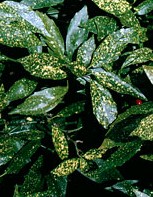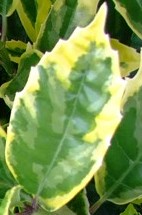 Japanese laurel is a broadleaf evergreen shrub native to Japan, China, and Korea, where it grows in shady moist sites. It is not related to other plants bearing the common name laurel and is in the Garryaceae family along with tassel bush (Garrya eliptca ) an evergreen shrub grown for its long catkins. The leathery leaves of Japanese laurel are broadly lanceolate, up to eight inches long, with coarsely serrated margins on their upper half. The small reddish purple male and female flowers are produced on different plants and appear in early spring. Male flowers are carried in upright terminal panicles while shorter clusters of female flowers form in the axis of the leaves and give way in the fall to 1/2″ red berry-like fruits with one seed. Many cultivars are available that differ primarily in leaf coloration some with marginal variegation and others with varying sized splashes of gold over the entire leaf surface. A shady protected location is important for Japanese laurel as the leaves develop their best color in shade and may burn in the sun. Since Japanese laurel is tolerant of shade, dry soil, and air pollution it is an excellent choice for many difficult sites. Plants also grow well in containers.
Japanese laurel is a broadleaf evergreen shrub native to Japan, China, and Korea, where it grows in shady moist sites. It is not related to other plants bearing the common name laurel and is in the Garryaceae family along with tassel bush (Garrya eliptca ) an evergreen shrub grown for its long catkins. The leathery leaves of Japanese laurel are broadly lanceolate, up to eight inches long, with coarsely serrated margins on their upper half. The small reddish purple male and female flowers are produced on different plants and appear in early spring. Male flowers are carried in upright terminal panicles while shorter clusters of female flowers form in the axis of the leaves and give way in the fall to 1/2″ red berry-like fruits with one seed. Many cultivars are available that differ primarily in leaf coloration some with marginal variegation and others with varying sized splashes of gold over the entire leaf surface. A shady protected location is important for Japanese laurel as the leaves develop their best color in shade and may burn in the sun. Since Japanese laurel is tolerant of shade, dry soil, and air pollution it is an excellent choice for many difficult sites. Plants also grow well in containers.
 Type: Broadleaf evergreen shrub
Type: Broadleaf evergreen shrub
Outstanding Features: Foliage, berries, tolerance of dry shade and salt spray
Form: Rounded
Growth Rate: Slow
Bloom: Small reddish purple in clusters in early spring
Size: 6-10′ H x 5-9′ W
Light: Part shade to full shade
Soil: Fertile, moist, well-drained but tolerates lean dry soil
Care: Trim in spring to shape
Hardiness: Zones 7-9
Pests and Diseases: Generally healthy but susceptible to nematodes, scale, mealyugs, root rot (in wet soil), Southern blight, and fungal leaf spot.
Propagation: Seed, stem cuttings
Outstanding Selections:
‘Varegata’ (yellow speckled leaves)
‘Picturata'(Yellow center and dusting on margins)
‘Golden King’ (Heavily blotched)
‘Crotonifolia’ (Heavily spotted)
‘Nana’ (3-5′ tall; both dark green and variegated forms)
‘Angustifolia’ (Long narrow all green leaves forms)